The Telecaster
 This
is another Leo Fender guitar produced in 1951, a renaming of the Broadcaster released one year before that. The Telecaster is a relatively straightforward guitar and a favourite with the author. It is known for having a bright, cutting tone, simple in operation with just two, 'single coil' pickups and a three position switch that covers all the options when selecting either one or combining two. The body was originally made in Ash, and models later in Alder. The neck's fret board is in either rosewood or maple with 22 frets on modern models, 21 on the older vintage reissue models of the 50s, 60s and 70s. The strings on a Telecaster are threaded through the body of the guitar then run over string guides on the bridge, a feature thought to contribute significantly to its sustained tone as the stings make firm contact with the body for sonic resonance. This
is another Leo Fender guitar produced in 1951, a renaming of the Broadcaster released one year before that. The Telecaster is a relatively straightforward guitar and a favourite with the author. It is known for having a bright, cutting tone, simple in operation with just two, 'single coil' pickups and a three position switch that covers all the options when selecting either one or combining two. The body was originally made in Ash, and models later in Alder. The neck's fret board is in either rosewood or maple with 22 frets on modern models, 21 on the older vintage reissue models of the 50s, 60s and 70s. The strings on a Telecaster are threaded through the body of the guitar then run over string guides on the bridge, a feature thought to contribute significantly to its sustained tone as the stings make firm contact with the body for sonic resonance.

Telecaster Controls
volume and tone
 Rear of Telecaster Rear of Telecaster
showing string hole ferrules
Keeping it simple, there are just two controls, one for volume and the other governs the tone of both pickups. The neck pickup is set at a slant so that the higher notes are captured at their brightest. Although available in a variety of versions that make it popular among renowned blues players, pop rock and 'indie' bands, the sound of the Telecaster perhaps remains most famously associated with country music when set up and amplified in such a way as to feature the use of a characteristic, rich 'twang' tone.

Tips:
The bridge position pickup in particular can sound very harsh and brittle if it is not of good quality. Single coil pickups, do sound brighter than their 'humbucker' counterparts and the slanted setting of the Telecaster bridge pickup is designed to capture tones giving a more treble edge. Care is needed in listening for tonal adjustments, whether on the guitar itself or the amplifier, to avoid the tone being too harsh or overly bright.
The Les Paul
 This has been produced by the Gibson guitar company since the 1950s, following up an idea and a design suggested by the legendary Les Paul, an exceptionally talented guitarist and, in the opinion of the author, a genius. This has been produced by the Gibson guitar company since the 1950s, following up an idea and a design suggested by the legendary Les Paul, an exceptionally talented guitarist and, in the opinion of the author, a genius.
The choice of a solid a body made of mahogany and topped with maple adds not only to the instrument's weight but also its sonic tonality and noticeable sustain. This is further enhanced by the fitting of two 'humbucker' pickups, a distinct characteristic of the Less Paul, and Gibson guitars generally.
The neck is made from mahogany with a rosewood fret board and has 22 frets. All fret boards are curved along the line of the fret and the Gibson guitars have flatter necks than the Fender Stratocasters and Telecasters reviewed above and, unlike them, the neck is glued to the body to form a solid one piece item - an important and further characteristic of the Les Paul and other Gibson guitars
 Each pickup has its own volume and tone control. A three position toggle switch selects either pickup, or combines both - the neck pickup position being labelled 'Rhythm' and the bridge pickup, with its more cutting tone, labelled 'Lead'. Each pickup has its own volume and tone control. A three position toggle switch selects either pickup, or combines both - the neck pickup position being labelled 'Rhythm' and the bridge pickup, with its more cutting tone, labelled 'Lead'.
The bridge comprises two pieces, a 'tailpiece' through which the strings are threaded and a 'Tune-o-matic' part over which the strings sit and which provides fine tuning of the guitar's 'intonation'.
 The Tune-o-matic bridge The Tune-o-matic bridge
During the sixties, Gibson produced a slimmer guitar, the 'SG', with two cutaways unlike the Les Paul which obviously has only one. Les Paul was not happy with the SG and wouldn't endorse it. It's out there still as a rock guitar, an icon in the band AC/DC's image, but the Les Paul, in various configurations has endured far greater popularity as exemplified through the blues of Mike Bloomfield and Peter Green, to the thicker, driven tones of Gary Moore and the style of rock emerging from the seventies with players such as Scot Gorman, the mainstay guitarist of the band 'Thin Lizzy'.
Les Paul Headstock and Schaler Tuners
The guitar is undoubtedly versatile, as affirmed by the playing of Mr. Les Paul himself who is an outstanding and excellent Jazz guitarist.
Tips:
The Les Paul, made from mahogany and having a solid body, is a heavy guitar, not comfortable for everyone. Its two humbuckers deliver distinctive and desirable tones of which one of two is generally used, either the bridge pickup with its bright yet 'thick' tones or neck pickup with its smoother, 'rounded' tones. Guitars fitted with three pickups offer more versatility in tone and it is worth knowing before selecting your guitar that the 'single coil' pickups, as traditionally fitted to, for example, a Stratocaster guitar, have a 'thinner' sound than the 'fatter' and fuller sound sound' of guitars fitted with 'humbuckers' such as the Les Paul.
The ES 335T
 The '335' style guitar first appeared in 1958 and thereafter some modifications occurred, such as a more elliptical neck being one of them together with some cosmetic touches. Key to this Gibson guitar is its slim, semi-hollow body made from three ply maple and a solid cente block also of maple. This makes the guitar lighter in weight than the Les Paul reviewed above, but it is larger in size. The neck is made from mahogany topped with rosewood for the fretboard which has 22 frets and glued to the body to form a solid connection The '335' style guitar first appeared in 1958 and thereafter some modifications occurred, such as a more elliptical neck being one of them together with some cosmetic touches. Key to this Gibson guitar is its slim, semi-hollow body made from three ply maple and a solid cente block also of maple. This makes the guitar lighter in weight than the Les Paul reviewed above, but it is larger in size. The neck is made from mahogany topped with rosewood for the fretboard which has 22 frets and glued to the body to form a solid connection
E355 Controls 
The pickup configuration is two 'humbuckers', each with its own volume and tone control. A three position switch selects each possible setting - neck, bridge or both pickups combined.
The bridge is the 'Tune-o-matic'', typical of a Gibson or Gibson style guitar, like that of the Les Paul, though there are models in which the strings are fed over the bridge via a different attachment to the end of the body.
 
The top of the body is arched, unlike other guitar styles reviewed so far. This together with its characteristic f-holes made it popular with Jazz and dance band players in the early years. With one slight variation or another, the guitar has been played by many a popular and well known players such as B.B. King (blues), Chuck Berry (rock) and Larry Carlton (Contempoary Jazz) and John Lennon and George Harrison of the Beatles (Pop).
Tips:
The guitar is larger than some others and may not suit everyone, particulary as it tends to be worn a little higher to the chest, particularly Jazz guitarists. But then again it all depends on the individual - you can do as you please - Chuck berry, you will notice, wore his quite low for his theatrical performances.
The tone too is characteristically more delicate that with the solid body guitars, but these things can be very shaped and assisted by the tonal settings of the amplifier as much as the guitar itself. I suggest you listen to the players I have mentioned above to discern its tone and versatility. I think also you will find the 335 played as a rhythm guitar on tracks such as Listen to the Music and Long Train Commin' by the Doobie Brothers.
The ES 175
 The first of these was produced in 1949 by the Gibson guitar company, originally with one singe coil pickup (a PAF 90)which during the late 1950s and onwards was fitted instead with two humbucker pickups. It is a hollow bodied guitar, three inches in depth, and, like the ES 335, is made using three ply maple. The depth of the guitar is three inches, deeper than the other reviewd above. The neck, made of mahogany and with a rosewod fretboard, has twenty frets and a fairly flat radius of 12 inches. Controls are generally typical of the Gibson style with two volume, two tone contols and a three position switch The first of these was produced in 1949 by the Gibson guitar company, originally with one singe coil pickup (a PAF 90)which during the late 1950s and onwards was fitted instead with two humbucker pickups. It is a hollow bodied guitar, three inches in depth, and, like the ES 335, is made using three ply maple. The depth of the guitar is three inches, deeper than the other reviewd above. The neck, made of mahogany and with a rosewod fretboard, has twenty frets and a fairly flat radius of 12 inches. Controls are generally typical of the Gibson style with two volume, two tone contols and a three position switch
Bridge and string guide feature of the ES 175

Tips:
In keeping with tradition and its origins, this guitar remains mostly identified with Jazz guitarists.
Electric Guitar Necks
Choosing a guitar that has a neck to suit you is an important consideration. Guitar necks will vary considerable in their design betwen one make of guitar and another and will have a significant impact upon the feel of the guitar to play, style of play, and an influence upon the tone of the instrument.
Length:
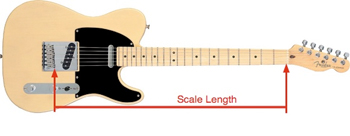 Guitar models will have necks of different lengths and this can make a noticeable difference to the feel of the guitar to play. The length to take into account is its 'scale length', which is not the length of the neck from one end to the other. It is a measurement from the saddle on the bridge to the 'nut' situated at the headstock end. (The nut is the slotted piece through which strings run, before the first fret, and the saddle is what the string sits upon as it leaves the bridge.) So it is really a measurement of the strings maximum vibrational length. Guitar models will have necks of different lengths and this can make a noticeable difference to the feel of the guitar to play. The length to take into account is its 'scale length', which is not the length of the neck from one end to the other. It is a measurement from the saddle on the bridge to the 'nut' situated at the headstock end. (The nut is the slotted piece through which strings run, before the first fret, and the saddle is what the string sits upon as it leaves the bridge.) So it is really a measurement of the strings maximum vibrational length.
If we take as examples two well known guitar makes, the scale length on a Fender, such as a stratocaster, or Telecaster, is 25.5 inches and on a popular Gibson it is 24.75 inches. As a consequence, and a key thing to note, the frets are more widely spaced on a longer scale neck than they are on a shorter scale neck. Not only is the difference noticeable in terms of how the neck will feel to play but a difference in tone is also noticeable. This is because the strings on a shorter scale neck will have less tension in them when reproducing the same note played on a string of longer vibrational length. On a short scale neck, the strngs will feel slacker and the tone deeper, whereas on a longer scale neck the strings feel tighte and tone often described as crisper.
Neck Shape:
The shape of a guitar neck's profile can be considered in terms of its curvature of front and back. This shape will have an affect upon comfort of the neck in the hand and, to some extent, an implication for the style of playing to which it can be best suited to also. The rear of the neck can be deep or shallow and three typical profiles have evolved. These are refered to as 'C' shape, 'U' shape and 'V' shape, where the letters are themselves illustrative of the shape implied. 'D' is another example. The most popular profile of guitar neck today is the C shape. As a rule, it's a resonably comfortable standard and therefore fitted to most models today. Older guitars necks, refered to as 'vintage' necks, prefered by the author, tended to have a 'U'' shaped profile and you can expect to find these on a re-issue model, though perhaps less deep deep some have noted than on the originals. Similarly the 'V' shape necks were an earlier design which is sometimes avaialble on guitars today and for which a hard and soft version exists which gives an indication of the sharpnes, or severity in the angularity of the 'V'. It depends really on what you find best fits into the palm of your hand and the 'C' shapoe, found on most necks, is usually fine.
Neck Width:
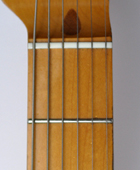 Guitar necks vary in width among different models and types. The width generally quoted is that at the nut, the first fret region. Fender electric guitars usually have a neck width of around 1.65 inches (42mm). Necks on, Gibson guitars, for another example, are usually a little wider at 1.695 inches. A standard classical guitar for comparison is around 2 inches in width at the nut. Peference would take into account comfort with regard to size of hand, length of fingers and style of play. Generaly, and perhaps not surprisingly, its easier to play faster notes on a slender neck and with a wider neck it is easier to avoid unintentionally muting strings. Guitar necks vary in width among different models and types. The width generally quoted is that at the nut, the first fret region. Fender electric guitars usually have a neck width of around 1.65 inches (42mm). Necks on, Gibson guitars, for another example, are usually a little wider at 1.695 inches. A standard classical guitar for comparison is around 2 inches in width at the nut. Peference would take into account comfort with regard to size of hand, length of fingers and style of play. Generaly, and perhaps not surprisingly, its easier to play faster notes on a slender neck and with a wider neck it is easier to avoid unintentionally muting strings.
Neck Radius: 
The neck radius refers to the amount of curvature, or roundness, in the fretboard and
this can vary significantly. If you think of curvature as the perimter of a circle then the shorter the radius of that circle the steeper the curve at its perimeter and therefore the greater the curve of fretboard. The tendancy for contemporary electric guitars today is to have a fairly flat neck. 'Vintage' or early Fender guitars, particualry those in the 50s, had a radius of 7.25 inches whereas a modern day standard Fender Stratocaster, for example, will have a radius of 9.5 inches. A neck of vintage radius will sit quite nicely in the hand for playing chords, and I find soloing also. Gibson guitars have a fairly flat radius of 12 inches and latter day guitar makers, such as Ibanez, Jackson and Warmoth, whose instruments have a close correlation to heavy rock, metal music etc, have in their range guitars with a radius even flatter still, up to 16 inches. PRS guitars similarly have a neck of shallow radius but this varies more moderately between 10 and 11.5 inches on different models. Warmoth, like Jackson, produce guitars with a 'compound' radius which is one where the neck tapers respectively from 10" to 16" in the case of Warmoth and 12" to 16" in the model made by Jackson.
The reason for these flatter necks is that the ability to 'bend' notes is more limited when the fretboard is highly rounded because the ringing of such a note is likely to be stunted when the string meets another fret. The action therefore (the distance between string and frets) can be set lower on a flatter neck which not only eases play and facilitates extremes of bending but also speed - a factor some players and their music require.
Fretboard:
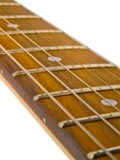 The fretboard, or fingerboard, on most electric guitar necks are made with either Maple, Rosewood or Ebony, usually with another wood backing it, usually either Maple or Mahogony, to form the overall shape, but not necessarily. The neck, including Fretbard, can be formed from one piece of Maple. As a player myself, familiar with each type of neck, I can tell there is a difference in how each feels to play. The Rosewood somehow feels softer than the maple and Ebony necks even though each are hard woods.The Rosewood also feels more 'oily', perhaps because the Maple necks tend to have a lacquer coating so you are not so much in touch with the wood itself. Comment abounds as to the tonal influence that the chosen wood of each fretboard brings, though given the intricate subtleties of other factors that combine to affect a guitars tone, notably the timbre in its amplification, I do not want this page to add any further vaguery upon the subject. The fretboard, or fingerboard, on most electric guitar necks are made with either Maple, Rosewood or Ebony, usually with another wood backing it, usually either Maple or Mahogony, to form the overall shape, but not necessarily. The neck, including Fretbard, can be formed from one piece of Maple. As a player myself, familiar with each type of neck, I can tell there is a difference in how each feels to play. The Rosewood somehow feels softer than the maple and Ebony necks even though each are hard woods.The Rosewood also feels more 'oily', perhaps because the Maple necks tend to have a lacquer coating so you are not so much in touch with the wood itself. Comment abounds as to the tonal influence that the chosen wood of each fretboard brings, though given the intricate subtleties of other factors that combine to affect a guitars tone, notably the timbre in its amplification, I do not want this page to add any further vaguery upon the subject.
Frets:

Now we are entering another area of personal preference for most guitar players. Frets come in a variety of shapes and sizes, narrow, medium and wide (Jumbo), not to mention height. Earlier guitars were made with the narrow, or 'vintage' fret wire. The wider frets do actually make the guitar easier to play and also facilitate faster playing because they require less pressure as the fingers move from one position to another on the fretboard. Wider frets also have the advantage of offering more metal with which the sting can make contact with the guitar. This would be a factor in a strings vibrational quality. Some well known electric guitar players are noted for their favouring of jumbo frets, such as Stevie ray Vaughan and Rory Galagher, sometimes replacing the vintage fret wire used on their original, vintage necks. For most, the standard or medium gauge is fine.
The frets themselves are generally made from brass (mostly) with nickel added to create the look of silver. These are quite hard wearing though and considered a good choice of balance between use and durability, though with lots of playing action they'll probably require replacement during the guitars lifetime. Newer stainless steel frets are emerging though these are not the norm.
Besides a neck's scale length, you also find mention of '21 fret' or '22 fret' neck models of guitar. This refers to the total number of frets the neck has. Earlier fender models originally had 21 frets and later models 22. Today either are readily available, one reflecting the vintage original character and the other a modern choice. Gibsons have 22 frets. Other makers have prodcuecd guitars with 24 frets such as PRS (Paul Reed Smith) guitars and their model for Carlos Santana.
Headstock:
This is the location of the tuners and forms a decorative attribute to the guitar.
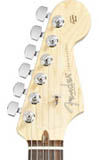 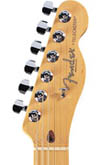 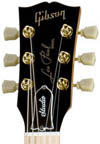   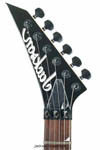
Tuners:
Tuners, or machine heads, have changed in design over the years but many of the features of the early models are still available. Having chosen your guitar, the choice of tuner would realstically be those fiited by its maker. Leading names in guitar tuners are Kluson, Schaller, Grover, Gotoh and Sperzel and their products have been variously fitted to leading guitar models. While choice of tuner manufacturer has fluctuated, the styles selected are synonymous with the following guitars: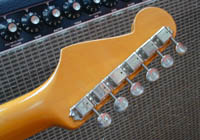
Kluson tuners fitted on Fender
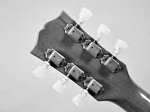
Tuners on Gibson
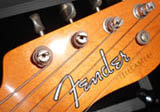
How the string is fitted to the machine head can be of value and interest to mention. In vintage Kluson tuners for example, those fitted to the early and reissue Fender modles, the stirng would be seated in a slot down the center of the spindle before being wrapped around it. Later spindles would have a hole in the side through which to thread the string.
A number of different tuner manufacturers are availbale with different designs that can be fitted to your guitar. Some examples are:
 by Fender by Fender by Grover by Grover By Gotoh By Gotoh
Tuners are also available that can be locked to hel the guitar to stay in tune. These will be found fitted the the Fensder Stratocaster Plus, for example.
The example of a locking nut shown here is made by Schaller: 
Truss Rod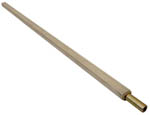
The neck of the guitar is under considerable stress, caused by the tightness of the strings which give a pull of aorund 150 - 120 pounds. Being wood, it could bend and bow under such conditions. To deal with this, most guitars have an adjustable metal truss rod embedded under the fretboard and that runs the length of the neck to compensate. If it is necessary to have this adjusted, it is advised to have it done by a professional guitar tech.
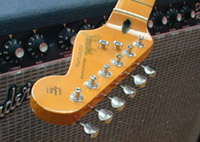 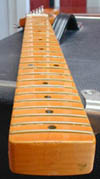
Access for adjusting the truss rod of this Stratocaster is available at the headstock end.
On vintage necks, the adjustemt would be at the other end of the neck.
Attachment of Neck to the Body of the Guitar:
There are three ways of attaching the neck to the body of an electric guitar. It can be bolted on, as with most Fender guitars, glued on with a tenon joint,as with most Gibson guitars, or a neck can be made as one piece with the guitar body.
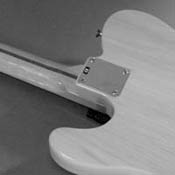
Telecaster showing the plate bolting the neck to the body
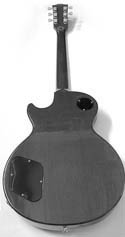
A set neck Les Paul Guitar
Electric Guitar Bridge
The Stratocaster bridge
One essential feature all electric guitar bridges share are the adjustable ''sadlles' upon which the string rests. This enables fine tuning whereby the length of the string can be adjusted to vibrate at the correct pitch. The amount of adjustment, forward and back, depends upon different gauges of string and different sizes of fret. Each saddle can have is height adjusted also.
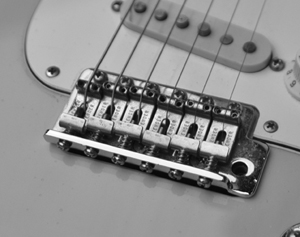
Vintage Stratocaster Bridge style.
A temolo tremolo arm is fitted in the hole to the right.
Strings are fed through holes from the rear of the bridge and over the saddle. As well as movement forwards and backwards, the height of the saddle is also adjustable to accommodate the preferred 'action' - the height of the string above the fretboard.
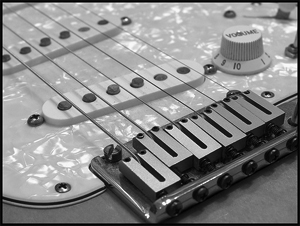
Contemporary Stratocaster Bridge
The stratocaster bridge has more elements beneath the bridge than are visible from above. Attached to the bridge and forming an intgral part is a tremlo block that fits inside the body of the guitar. The bock forms part of the tremlo system incoproating springs that are attached on the underside of the body. A plastic cover normally covers these. The way in which the screws support and attach the assembly to the body can also be adjusted and this will affect the feel and operation of the tremolo arm and, it is said, the guitar's tone.
It is pointed out by makers of replacement tremelo blocks such as Callaham that the material from which the block is made will affect the sonic tone of the instrument. The original block used on stratocasters from the USA was made from steel without any lead content, because lead would dampen the tone. A stratocaster made outside of the USA they say is most likely to be fitted with a block made from zinc. They also point out that a block fitted to standard issue American stratocastersis is likely to be a soft cast steel block whereas originally it would been made of hot rolled leaded steel which is what Callaham use to mnake their replacement bridges from.
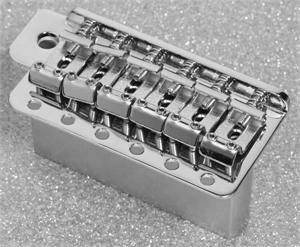
Tremolo block
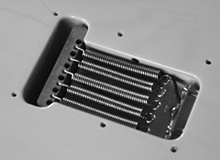
Springs attached to block
cover removed
Telecaster Bridge
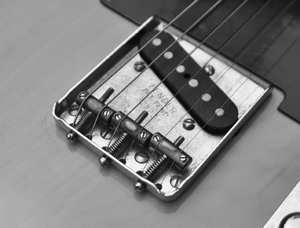
Vintage
The original Telecaster had three brass saddles of which a newer version is available with six saddles, usually chrome plated on modern guitars. The saddle design has varied a little over the years. Strings are fed through holes from the rear of the body and over the saddle.The 'ashtray' liped edge, to which coud be fitted a cover, has been removed on contemporary models such as the one below which is the bridge fitted to the author's Telecaster Plus model.
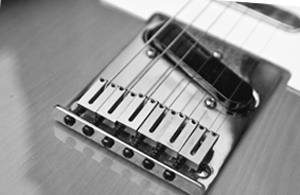
A contemporary bridge version fitted to a Telecaster Plus
Gibson's 'Tunomatic' Bridge
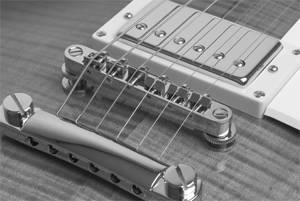
The tunomatic bridge was design by the president of president of Gibson guitars Ted McCarty. It was first fitted the the Les Paul Custom model, then theLes Paul 'Gold Top' standard and others Gibsons models thereafter. Wheels at either side of the bridge enable the height to be raised and each saddle is adjustable to accurately affect the intonation of the insturment.
The bridge works with a stop bar tail piece which is securely bolted to the body giving good coupling between string and body, helping to create sustain. Tailpieces do have variations such as this shown to the right on an Epiphone 335 model.
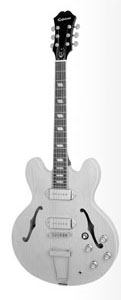
The bridge works with a stop bar tail piece which is securely bolted to the body giving good coupling between string and body, helping to create sustain. Tailpieces do have variations such as this shown to the right on an Epiphone 335 model.
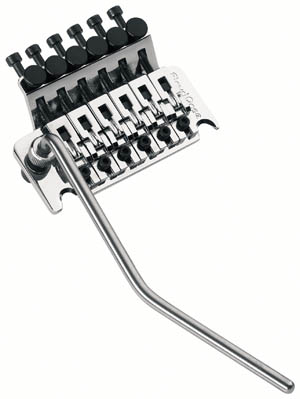
A Floating Bridge:
A normal tremolo arm is pushed downwards to affect the pitch of the stings. There is another type of bridge besides standard tremolo bridge, the floating bridge. This enables both a downward and an upward motion, given a more pronounced effect than a standard tremelo bridge. This kind of bridge uses string tension to hold it up, and tension in springs to pull it back. It has to be set up carefully to work well because there needs to be perfect equilibrium between the springs in the back of the guitar and the strings on the front in order to create the desired result and the effect of a 'floating' bridge. It is most likely that your guitar would be fitted with such a bridge from the start rather than be fitted subsquently.
There are several makers of floating bridge of which that made by Floyd Rose is a well known example and shown above here.
Electric Guitar Pickups
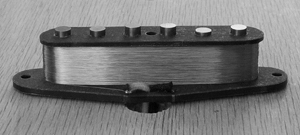
There are two kinds of pickup used on electric
guitars. These are known as the 'single coil' and the 'humbucker'. Each provides a discernable difference in tone for the guitar. Typically, the single coil varieties are fitted to Fender guitars such as the Stratocaster and Telecaster, and the humbucker generally fitted on Gibson guitars. Both makers offer a range of guitars that will have alternative configerations to this generalisation. With a little knowledge of pickups, and a discerning ear, you will be able to make decisions about the choice of pickups on your guitar. The pickups fitted to a guitar can be removed and altered. It is not a dfficult task, though it would require some experinece of soldering and the appropriate tools - so perhaps best left to someone who knows what they are doing.
Pickups: Tone
Writing about tone is difficult - it is best heard, but I will have a go at describing the difference in tone between the single coil and humbucker varieites of pickup.
The single coil has a thinner, lighter sound than a humbucker. It's rendition of tone across the range from treble, middle to bass will be clear and the frequencies at the top end, the high notes, notably present. The humbucker generally delivers a thicker, stronger tone, normally with less treble discernable in the higher notes. This is because the constuction of the humbucker has a natural tendancy to cancel out these frequencies a little. If you listen to the guitar played by Robert Cray, for example, you will hear a charcteristic tone delivered by single coil pickups on a Stratocaster guitar. Compare this with the tones delivered by a Gibson 335 guitar played, for example, by Larry Carlton and using humbuckers. The Les Paul 'Gold Top' as played by Peter Green of 'Fleetwood Mac' would be an example in which a Gibson model is ftited with single coil pickups - the PAF 90s. I recommend you listen to a variety of players to establish an ear for pickups and their tonal possibilities.
The amplification of the guitar and how it is used, will also add some colouration to the tone you hear. Guitarists tend to work with either a 'clean' tone, the aim of which is to provide undistorted notes and a faithful rendition of the instrument, or a 'dirty' tone which is when the amp (or an effects box) is set to clip the tones to a varying degree of distortion. Although the amplifier and a variety of effects can be applied, you may still recognise the tones that are emanating from either single coil or humbucker pickups.
Pickups: Alnico and Ceramic Magnets
A pickup uses a magnet around which is a coil of very fine enamaled copper wire. When the string vibrates in the firld of the magnet, an electric current is produced and it this that is sent to the amplifier. One of two types of magnets will be used in an electric guitar pickup. Alnico is one and ceramic is another. Alnico magnets are made made by mixing aluminium, nickel and cobalt with iron. They are traditionally used in "Classic" and "Vintage" pickups, giving a mellow tone , smooth response and a moderate output. Their magnetic strength can decline over time.
Ceramic or Ferrite magnets are cheaper to make than alinico ones and used on lower cost instruments. They are made using a mix of Stontium and iron and have a lower magnetic strength than alinco pickups. The tone from a ceramic pickup can be noticebly brighter with more treble pressence than an alnico pickup.
Pickups: Wire
A pickup's characteristics in tone or output strength will also be affected in tone by the the thickness of the wire and the number of turns around the magnet. Some pickups, among them the more expensive ones, will have 'hand-wound' coils while most are machine wound. The original guitar pickups of the 50s were hand wound from which discussion follows that these coils, with their less consistent or regular winding than a machine turned pickup, leads to a characterictic and discernable differeence between a 'vintage' pickup and a modern one. I will leave it for you to set up the test one day maybe and decide. Pickup makers can select different gauges of wire and alter the number of turns of the coil to adjust both its tonal response and strength of output. This is useful for example if your guitar is primarily for clean tones or dirty tones where the pickup can help 'drive' the amplifer into distortion by having a higher level of output signal.
Single Coil and Humbucker: Physical differences
Pickups can come in different shapes and sizes but essentially single coil pickups have one coil, as the name implies, and a himbucker two coils. Single coild pickups can tend to pickup stray radio frequencies which you will hear as a buzzing sound from your amp when you guitar is near it. By using two coils each wound in the alternate direction to the other, the interference is cancelled.
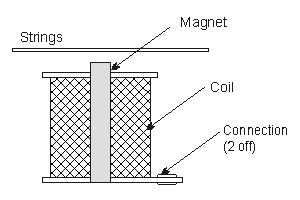 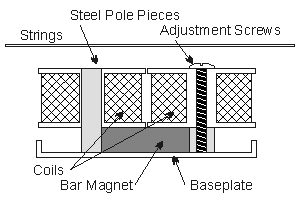
Guitar Video - Guitar Players, Learn Acoustic or Electric Guitar |



